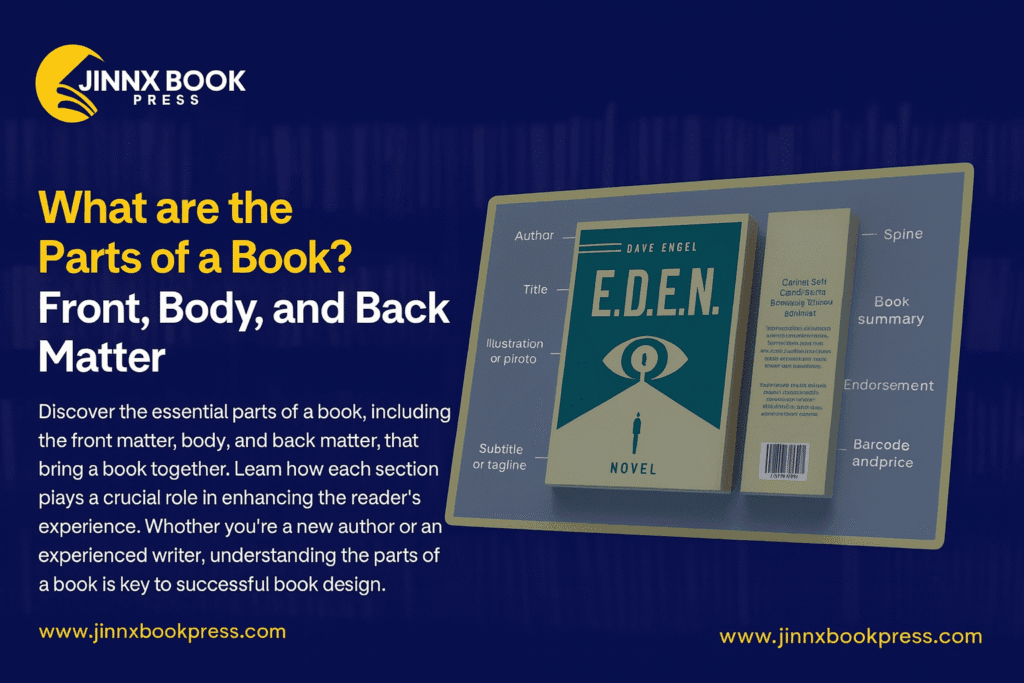Key Takeaways: What Are the Parts of a Book? Front Matter, Body, and Back Matter Explained
Introduction
Whether you’re writing fiction or nonfiction, understanding the structure of a book is essential for crafting a polished and professional manuscript. Every book is composed of three main sections:
- Front Matter – The introductory elements of the book that set the tone and provide important background information.
- Body – The main portion of the book where the narrative or subject matter is presented in full detail.
- Back Matter – The concluding segment that offers supplementary material and additional context.
Each section plays a vital role in delivering a seamless reading experience. In this blog, we’ll break down every part and explain how understanding them can elevate your writing.
Turn Your Book into a Bestseller
Once you’ve built each section of your book, Jinnx Book Press can help you bring it to life. We offer end-to-end self-publishing services including editing, formatting, cover design, printing, and distribution.
Get Started with Self-Publishing Services Today
Part 1: Front Matter – Welcoming Readers into Your Book
- Accolades: Endorsements, awards, or critical praise that establish credibility.
- Half-Title Page: A minimalist page featuring only the book’s title.
- Copyright Page: Copyright details, ISBN, edition info, and publisher data.
- Title Page: Formal presentation of the book’s title, subtitle, author name, and publisher.
- Dedication: A personal note from the author to someone special.
- Acknowledgments: Thanks to those who contributed to the book.
- Preface/Foreword: An intro from the author or guest.
- Table of Contents: A structured roadmap for the book.
The front matter sets the tone and builds anticipation. It’s especially important in nonfiction where authority and organization matter.
Part 2: The Body – The Heart of Your Book
This is where your core content lives. It includes:
- Prologue (for fiction): A teaser or backstory.
- Introduction (for nonfiction): Framing your topic and goal.
- Chapters: Dividing content into digestible units.
- Epilogue (for fiction): A reflective close or future hint.
- Conclusion (for nonfiction): Summary and final takeaways.
This is where your creativity or expertise shines. Good structure, pacing, and flow keep readers hooked.
Part 3: Back Matter – Your Book’s Finishing Touches
Often overlooked, the back matter enhances the book’s value. It may include:
- Afterword: Post-publication thoughts from the author.
- Appendices: Supporting documents or charts.
- Addendum: Updates added later.
- Glossary: Definitions for key terms.
- Index: A searchable reference of topics.
- Endnotes/Footnotes: Supporting citations.
- Bibliography: Sources referenced in the book.
- Copyright Permissions: Usage rights for third-party material.
- Author Bio: Share your story and background.
- Coming Soon: Teasers for future books or sign-up links.
This section builds trust, boosts credibility, and encourages return readers.
Conclusion
Understanding the full structure of a book allows you to create a more cohesive, reader-friendly manuscript. Each section serves a purpose, guiding the reader from start to finish.
Whether you’re writing your first novel or building a nonfiction brand, Jinnx Book Press is here to support your journey from idea to publication.
Ready to publish your book the right way? Contact Jinnx Book Press today and take the next step toward literary success.
Pro Tips for Authors
Structure isn’t just about order—it’s about impact. Consider these tips:
- Use the Table of Contents to highlight key themes.
- Include a glossary for technical or fantasy terms.
- Add a character list, timeline, or map in fiction books.
- Ensure citations and appendices are clear in nonfiction.
- Make your author bio personal, relevant, and engaging.
Common Mistakes to Avoid
Avoid these issues to improve reader experience:
- Skipping the front matter or formatting it poorly
- Confusing chapter titles or poor flow
- No bibliography in nonfiction
- Using an epilogue to start a new story arc
- Forgetting helpful back matter content
Optimizing for SEO and Discoverability
A well-structured book is also a marketing tool:
- Use keywords in your titles
- Mirror reader search intent in your Table of Contents
- Include links to your author website and newsletter
- Add a “Coming Soon” teaser
- Use proper metadata for eBooks
A well-planned structure can boost your book’s visibility and long-term success.


